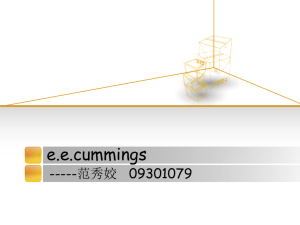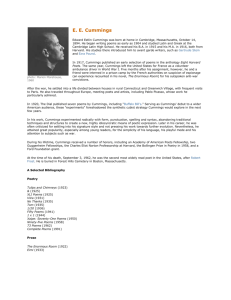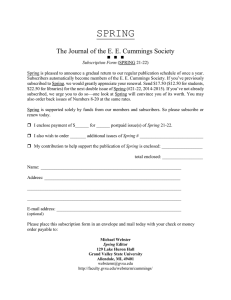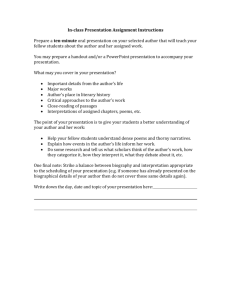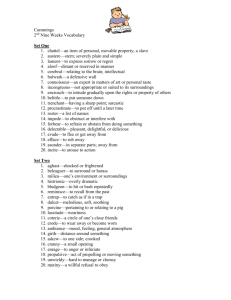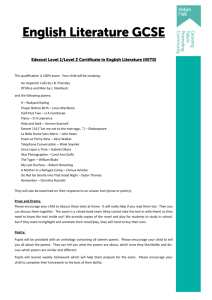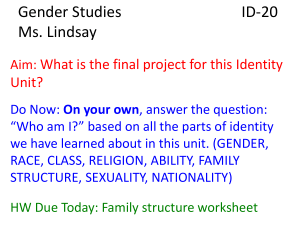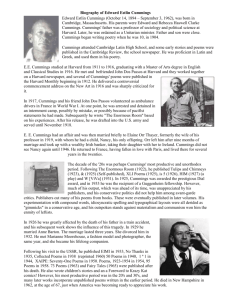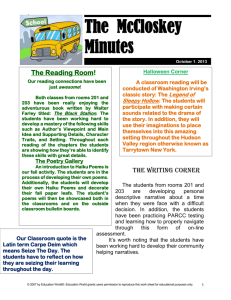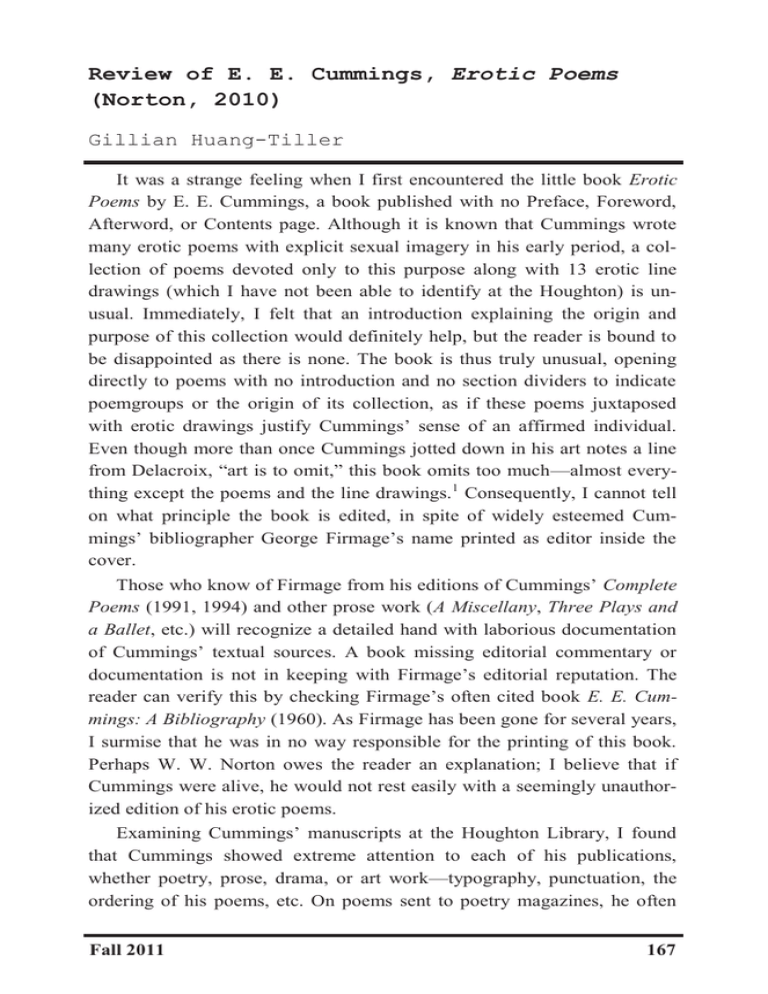
Review of E. E. Cummings, Erotic Poems
(Norton, 2010)
Gillian Huang-Tiller
It was a strange feeling when I first encountered the little book Erotic
Poems by E. E. Cummings, a book published with no Preface, Foreword,
Afterword, or Contents page. Although it is known that Cummings wrote
many erotic poems with explicit sexual imagery in his early period, a collection of poems devoted only to this purpose along with 13 erotic line
drawings (which I have not been able to identify at the Houghton) is unusual. Immediately, I felt that an introduction explaining the origin and
purpose of this collection would definitely help, but the reader is bound to
be disappointed as there is none. The book is thus truly unusual, opening
directly to poems with no introduction and no section dividers to indicate
poemgroups or the origin of its collection, as if these poems juxtaposed
with erotic drawings justify Cummings’ sense of an affirmed individual.
Even though more than once Cummings jotted down in his art notes a line
from Delacroix, “art is to omit,” this book omits too much—almost everything except the poems and the line drawings. 1 Consequently, I cannot tell
on what principle the book is edited, in spite of widely esteemed Cummings’ bibliographer George Firmage’s name printed as editor inside the
cover.
Those who know of Firmage from his editions of Cummings’ Complete
Poems (1991, 1994) and other prose work (A Miscellany, Three Plays and
a Ballet, etc.) will recognize a detailed hand with laborious documentation
of Cummings’ textual sources. A book missing editorial commentary or
documentation is not in keeping with Firmage’s editorial reputation. The
reader can verify this by checking Firmage’s often cited book E. E. Cummings: A Bibliography (1960). As Firmage has been gone for several years,
I surmise that he was in no way responsible for the printing of this book.
Perhaps W. W. Norton owes the reader an explanation; I believe that if
Cummings were alive, he would not rest easily with a seemingly unauthorized edition of his erotic poems.
Examining Cummings’ manuscripts at the Houghton Library, I found
that Cummings showed extreme attention to each of his publications,
whether poetry, prose, drama, or art work—typography, punctuation, the
ordering of his poems, etc. On poems sent to poetry magazines, he often
Fall 2011
167
stamped his submission with this phrase: “please send proof to”—and he
also provided an extra sheet of editorial instruction at the front of his manuscripts. For example, in his “Notice for XAIPE,” he instructs the linotypist,
“please set each poem EXACTLY as in this MS kindly note the space.” 2
Most of Cummings’ readers might remember how displeased he was by the
changes made without his knowledge in the first edition of The Enormous
Room. He wrote in a letter from Paris, dated “14 mai 1922”: “(P.S. AS IT
STANDS the book is not merely an eye-sore but an insult)” (Letters 88).
Cummings, known as a modernist experimental lyric poet of spring,
love, sex, and feeling in addition to his satiric stance against the collective,
would probably not object to having his erotic poems collected in one volume. For example, T. R. Smith’s anthology Poetica Erotica: A Collection
of Rare and Curious Amatory Verse (1931) reprinted 16 of Cummings’
“Sonnets–Actualities” from & [AND] (1925) and “she being Brand” from is
5 (One, 19). Embracing “aliveness” and “IS,” Cummings also “feels” sex
as action and as negation of death or inaction. 3 However, without his own
selection of poems or erotic drawings or his permission to have his erotic
drawings juxtaposed to poems, the provocative and radical display of the
text and drawings together only undermines the art of suggestiveness of
both. One thing he would have objected to: stifling and foreclosing the
spontaneity of feeling and freedom of the reader’s imagination in art or in
poetry. Two of his most audacious art pieces are cases in point: one juxtaposed with the well known “O It’s Nice To Get Up In,the slipshod mucous
kiss” (Erotic Poems 27) and the other with “she had that softness which is
falsity” (EP 67). In contrast, Richard Kostelanetz in his AnOther E. E.
Cummings (1998), highlighted both sonnets in his selections, but presented
them without the distracting drawings so that the reader can appreciate
what Kostelanetz means by calling Cummings “the finest erotic poet of his
generation” (43).
In 1943, Cummings wrote to an editor who wanted to pair his poems
with drawings:
so far as I’m concerned,each poem is a picture γραφή - γραφω “I
write”(whence our word “graphic”)but originally “I make
lines”—cf the Poet-Painter of China)and the paperspace around
each poem is a where in which it heres or a surface on which it
floats. Consequently,line-drawings-on-the-poempage strike me
(much as I love to write by drawing)as redundant4
168
Spring 18
We could applaud the publisher’s wish to put a new Cummings book on the
shelf. But a serious and careful poet like E. E. Cummings, who sought a
transcendent feeling of wholeness through love, sex, nature, and everything
else, does not seem to be represented adequately by a book of randomly
selected erotic poems with arbitrarily interspersed line drawings.
Regarding Cummings’ seriousness about his work and numerous revisions of his love lyrics (witnessed in his Houghton MSS.), the book needs
to inform the reader of the time period and the context for these 50 erotic
poems, as well as line drawings. Matching the first line of the erotic poems
with the Index entries in Firmage’s edition of Complete Poems (1994), I
find that the first 17 poems and sonnets are taken from Tulips & Chimneys
(1922 manuscript), eight from & [AND] (1925), two (“she being Brand”
and “(ponder,darling,these busted statues”) from is 5 (1926), one (“may i
feel said he”) from No Thanks (1935), and one (“wild(at our first)beasts
uttered human words”) from 73 Poems (1963). The rest of the 21 poems are
all from Etcetera: The Unpublished Poems (1983). Most of the selections
were written around 1919-1920, a period of formal innovations and rebellion against genteel conventions. Some from Tulips & Chimneys could
have been written even earlier as they deal with erotic encounters in Paris,
where Cummings volunteered as a Norton-Harjes ambulance driver in 1917
(cf. Dreams 184). Some from “Sonnets-Realities” (T & C) deal with the
demimonde world of Boston in his Harvard years (cf. Dreams, 185; Revisited 63-65). Others from “Sonnets-Realities” were his erotic fantasies while
at Camp Devens in 1918 (Revisited, 33-35). (Cummings was drafted into
the U. S. Army after his December 1917 release from detention at La Ferté
Macé on false espionage charges.) Those from “Sonnets-Actualities” (T &
C) were mostly completed before 1920 when Cummings fell deeply in love
with Elaine Orr (Dreams, 194-95). Even though the last seven erotic poems
appear in the section titled “Late Poems, 1930-62” of Etcetera, they were
not really late poems, as we can tell by the brown frail sheets of some of
these poems in the MS folders. For example, the poem “b” (EP 71) began
as a radical experiment of visual poetry during his early phase (cf. Dreams
118-122 and AnOther Cummings 140). With a few exceptions, this collection mainly serves as a point of entry to a younger Cummings.
As a poet of “spring,” “aliveness,” “wholeness,” and “IS,” Cummings’
eroticism of sexual coupling deepened over the years. Sexual love and the
sexual union of “IYou” (No Thanks 57; CP 442) increasingly connotes a
more nuanced feeling that includes, but is not limited to, vulgarity or youthFall 2011
169
ful lust and desire (Dreams 186). Try reading aloud his “(once like a
spark)” and one of Cummings’ favorites, “one’s not half two. It’s two are
halves of one:” from his ninth collection of poems 1 x 1 (One Times One
1944), and you will realize what this collection has missed. Printing mostly
early erotic poems outside of the context of each publication and arbitrarily
juxtaposing erotic drawings with the poems to represent an “erotic” Cummings, this selection will probably not give the reader a proper understanding of sex and love as Cummings’ metaphor for death, rebirth, growth, and
self-transcendence. The book Erotic Poems would be more welcome if it
provided thoughtful coverage, explanatory notes, and documentation. In its
current state, it is rather a book for the collective unworld, and a book that
Cummings himself would very likely have been displeased with.
—University of Virginia-Wise
Notes
1.
E. E. Cummings collection, Houghton Library, Harvard University,
bMS Am 1892.7 (55)
2.
E. E. Cummings collection, Houghton Library, Harvard University,
bMS Am 1823.4 (98)
3.
“ ‘Death’ and ‘Sex.’ ” MS. notes. Houghton Library, Harvard University, bMS Am 1892.7 (57), folder 4 of 4, sheet 65
4.
Houghton Library, Harvard University, bMS Am 1892.7 (219), folder
8.
Works Cited
Cummings, E. E. Complete Poems 1904-1962. Ed. George James Firmage.
New York: Liveright, 1994.
—. Erotic Poems. Ed. George James Firmage. New York: Norton, 2010.
—. Selected Letters of E. E. Cummings. Ed F. W. Dupee and George Stade.
New York: Harcourt, Brace & World, 1969.
Firmage, George James. E. E. Cummings: A Bibliography. Middletown,
CT: Wesleyan UP, 1960.
Kennedy, Richard S. Dreams in the Mirror: A Biography of E. E. Cummings. New York: Liveright, 1980.
170
Spring 18
—. E. E. Cummings Revisited. New York: Twayne, 1994.
Kostelanetz, Richard and John Rocco, eds. AnOther E. E. Cummings. New
York: Liveright, 1998.
—. Smith, T. R., ed. Poetica Erotica: A Collection of Rare and Curious
Amatory Verse. New York: Horace Liveright, 1931.
Fall 2011
171

